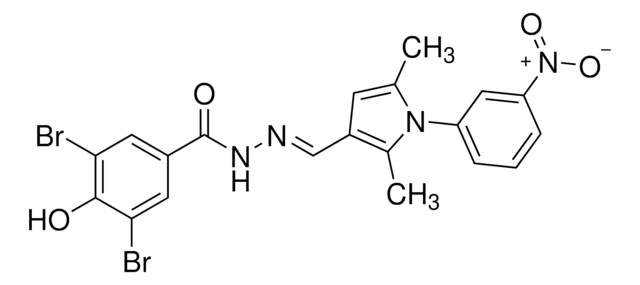M8515
Monastrol
≥98% (HPLC), solid
Sinónimos:
4-(3-Hydroxyphenyl)-6-methyl-2-thioxo-1,2,3,4-tetrahydro-4H-pyrimidin-5-carboxylic Acid Ethyl Ester
About This Item
Productos recomendados
Quality Level
assay
≥98% (HPLC)
form
solid
storage condition
protect from light
color
white to off-white
mp
185-185.9 °C (lit.)
solubility
DMSO: >5 mg/mL
storage temp.
2-8°C
SMILES string
CCOC(=O)C1=C(C)NC(=S)NC1c2cccc(O)c2
InChI
1S/C14H16N2O3S/c1-3-19-13(18)11-8(2)15-14(20)16-12(11)9-5-4-6-10(17)7-9/h4-7,12,17H,3H2,1-2H3,(H2,15,16,20)
InChI key
LOBCDGHHHHGHFA-UHFFFAOYSA-N
Application
- to treat MDA-MB-231 cells as a non-microtubule-targeting agent
- as a antineoplastic agent, to treat mouse myeloma cell line SP 2/0, to induce apoptosis and to elucidate the role of metabotropic glutamate receptor 3 (Grm3) in apoptosis
- as an inhibitor of pteridine reductase in GFP-transfected promastigotes infected macrophages for flow cytometer-based growth inhibition assay and to evaluate anti-leishmanial activity of Leishmania donovani hamster model in vivo
Biochem/physiol Actions
Features and Benefits
Packaging
Storage Class
11 - Combustible Solids
wgk_germany
WGK 3
flash_point_f
Not applicable
flash_point_c
Not applicable
ppe
Eyeshields, Gloves, type N95 (US)
Elija entre una de las versiones más recientes:
¿Ya tiene este producto?
Encuentre la documentación para los productos que ha comprado recientemente en la Biblioteca de documentos.
Contenido relacionado
Apoptosis, or programmed cell death (PCD), is a selective process for the removal of unnecessary, infected or transformed cells in various biological systems. As it plays a role in the homeostasis of multicellular organisms, apoptosis is tightly regulated through two principal pathways by a number of regulatory and effector molecules.
n proliferating cells, the cell cycle consists of four phases. Gap 1 (G1) is the interval between mitosis and DNA replication that is characterized by cell growth. Replication of DNA occurs during the synthesis (S) phase, which is followed by a second gap phase (G2) during which growth and preparation for cell division occurs. Together, these three stages comprise the interphase phase of the cell cycle. Interphase is followed by the mitotic (M) phase.
Nuestro equipo de científicos tiene experiencia en todas las áreas de investigación: Ciencias de la vida, Ciencia de los materiales, Síntesis química, Cromatografía, Analítica y muchas otras.
Póngase en contacto con el Servicio técnico








